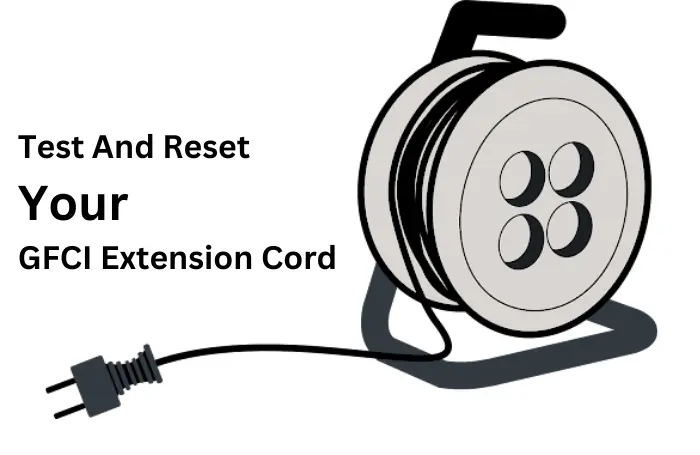GFCI outlets monitor electricity flow and cut power to your devices when they detect an imbalance. That safeguards users from electric shock and electrocution. Although GFCI extensions can handle high-voltage, voltage surges from normal usage, lightning, and utility switching can cause damage.
Damaged GFCI outlets in kitchens, bathrooms, and other areas are a threat to your family and can lead to electrocution, shock, or fire outbreaks. You can follow these steps to test and reset your GFCI extension when you detect abnormalities or failures.
Inspect Your Extension Cord
Visual damages like exposed wires, fraying, and cuts often compromise the cord’s functionality and safety. They increase the risk of electrical shock, fires, and even electrocution. Conduct an extensive evaluation of the external components of your GFCI extension cord, ensuring they are in sound condition.
Stop using cords with faulty exteriors and replace them immediately. Damaged cords seldom provide enough protection and often lead to electrical hazards. Carefully inspect the cord connections, checking each unit. You want to ensure the plug securely fits into the outlet and has no partial or loose connections.
Check for pinches, tangling, and kinking on the cord. Replace cords with such conditions because they are prone to internal overheating and damage.
Test the Cord
GFCI electrical cord testing involves validating its functionality. You will verify if the cord will trip and cut off power to your devices during ground faults. You plug the cord into your power outlet and the testing device into the cord. It can be a dishwasher, lamp, fan, or laptop. The outlet should be in sound working condition and correctly wired to offer a more reliable test.
Find the test button on the GFCI and connect your extension cord. The red-colored button tests while the green or black button resets the cord. Pressing the test button simulates ground fault, cutting off power to the extension cord. That leaves plugged-in devices without a power connection.
The GFCI produces a click sound to indicate power tripping after you click the test button. When the power flow to the cord and test device stops, it shows the GFCI plug is in sound working condition.
You may like to read: 2023-1954: Bridging the Gap Between Eras and Advancements!
Reset the Cord
If clicking the GFCI cord test button fails to stop power flow, your cord has underlying issues. You can prove that by clicking the reset button on your GFCI plug and cord. The reset button restores power to your extension, directing electricity to connected devices. The GFCI produces a distinct click sound when you engage the reset button. It indicates a successful reset process and power restoration.
Confirm whether power flows to the extension cord by plugging in a small appliance. The device should power on as expected. That confirms the functionality of the cord and the correct flow of electricity through the GFCI plug. Also, it confirms the GFCI extension cord offers the required protection against electrical faults.
Verify the Cord Works
Resetting the GPCI cord does not necessarily lead to power restoration. The first reset seldom guarantees results. In cases where the first reset attempt fails, you want to several other times to ensure the cord works. After testing the cord with a testing device and the device fails to work, it indicates either the device or the GFCI extension cord has issues.
You must verify if the testing device is working before you conclude that the cord has problems. Reset the GFCI several times to test devices in sound conditions.
Troubleshoot Your GFCI Cord
The possible reason for a power cord to trip is when the connected devices have underlying issues. Yet, your GFCI cord sometimes cuts power flow even after a reset when it has underlying issues. You can troubleshoot the cord to uncover and repair faults. Outlets in moisture-prone areas like outdoors and the bathroom might have suffered water damage.
Cords that have come into contact with moisture or water will often trip. You want to inspect the outlet for signs of moisture or water and ensure you dry it correctly before attempting a reset. Unplug devices from the power cord before resetting the GFCI plug. If it works, the apparent cause is a malfunctioning device.
Your GFCI power cord will also fail because of underlying wiring issues. Such faults are more complex and usually require professional handling. If you can, power off the extension cord before troubleshooting wiring issues.
Find here : Why is the //vital-mag.net Blog So popular among bloggers?
Call a Professional
If the testing, resetting, and troubleshooting fail to solve the problem, you might need skilled hands. The easiest way to solve that problem is to contact your electrician for a detailed inspection and repairs. You want to hire a qualified and credible professional with expertise in handling repairs like the one you have. Local electric repairs could be significant, especially for emergency repair problems.
Wrapping Up
The last thing your family wants to deal with is injuries and fatalities from electrical cord electrocution and shock. But that happens when you fail to check and maintain your GFCI power cords in sound conditions. These tips enable you to test, reset, and troubleshoot your power cord when it fails. You can quickly identify problems and resolve them using these strategies. You want to test your power cord, reset it several times, and hire a professional to troubleshoot common issues.
I’m Kishan Rana, an IT engineer and avid technology enthusiast. Blogging is my passion and I love to write about technological wonders. Being an SEO professional with around 8 years of experience with good leads I provide SEO services to top-level companies around the globe.



